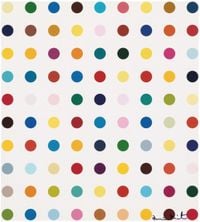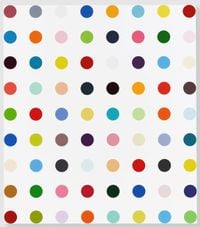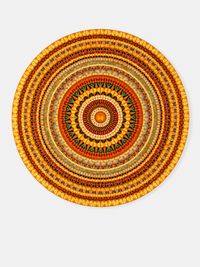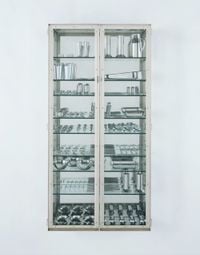In his irreverent, thought-provoking, and compelling artworks encompassing installation, sculpture, painting, and drawing, Damien Hirst examines the complexities of art, religion, science, and human life.
Read MoreDamien Hirst graduated with a BA from Goldsmiths College, London, in 1989. He quickly rose to prominence for his innovative and even controversial artworks, winning the Turner Prize in 1995. The centerpiece of his Turner Prize exhibition was Mother and Child (1993), in which bisected bodies of a cow and calf appeared preserved in formaldehyde solution.
Hirst is also one of the Young British Artists, a loose group of rebellious young artists who began exhibiting together in 1998. Titled Freeze, the inaugural YBA exhibition was led by Hirst and presented in an empty building in London. Many of the YBAs, among them Tracey Emin, Sarah Lucas, Gary Hume, Chris Ofili, and Gillian Wearing, are now internationally-recognised artists.
Many of Hirst's works revolve around the central theme of death, compelling the viewer to confront their own fears of mortality. Among his most notable works are The Physical Impossibility of Death in the Mind of Someone Living (1991), a shark suspended in a vitrine filled with formaldehyde in, and For the Love of God (2007), a human skull completely encrusted in diamonds.
Hirst is also recognised as a disruptive player in the art world. This has involved consigning his own works to an auction house for a one-vendor sale and co-founding the art-based publishing company Other Criteria, which sells his own editions and multiples. In 2015, Hirst opened his own art gallery, Newpoort Street Gallery, in London.
The first retrospective of Hirst's work, The Agony and the Ecstasy, took place at the Museo Archeologico Nazionale, Naples, in 2004. A later retrospective at the Tate Modern in 2012 recognized Hirst's contributions to British art over the last three decades.
Selected solo exhibitions include Mental Escapology, presented across five venues in St Moritz (2021); End of a Century, Newport Street Gallery, London (2020); Mandalas, White Cube Mason's Yard (2019); Visual Candy and Natural History, Gagosian, Hong Kong (2017); Damien Hirst: The Last Supper, National Gallery of Art, Washington, D.C. (2016); Damien Hirst, Astrup Fearnley Museum, Oslo (2015).
Selected group exhibitions include Icons: Worship and Adoration, Kunsthalle Bremen (2019); Objects of Wonder: From Pedestal to Interaction, ARoS Aarhus Kunstmuseum (2019); Book of Beasts: The Bestiary in the Medieval World, The J. Paul Getty Museum, Los Angeles (2019); Sculpture on the Move 1946—2016, Kunstmuseum Basel, Switzerland (2016); All You Need is LOVE: From Chagall to Kusama and Hatsune Miku, Mori Art Museum, Tokyo (2013); Regarding Warhol: Sixty Artists, Fifty Years, The Metropolitan Museum of Art, New York (2012).
Ocula | 2021









